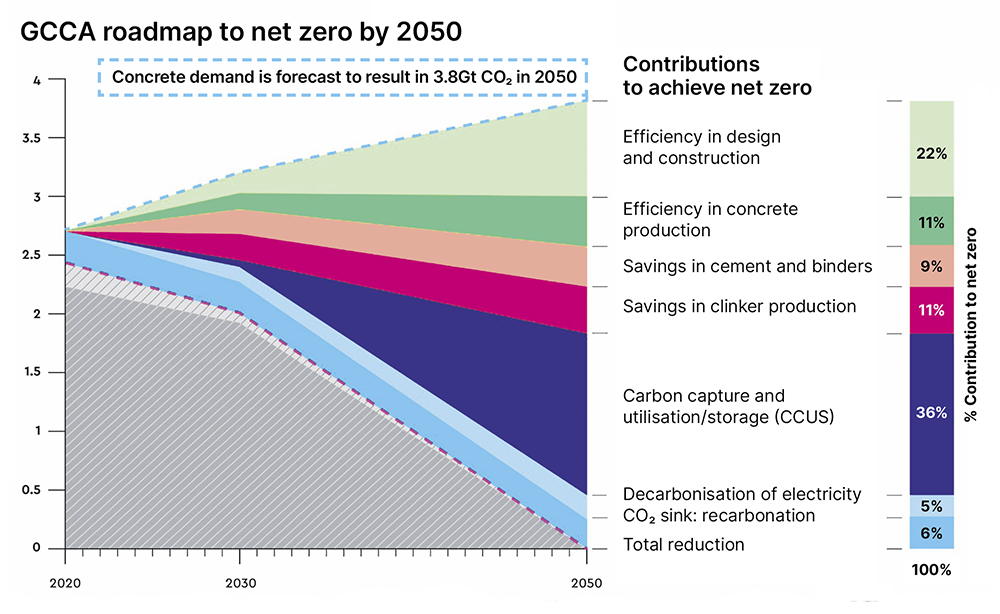
The concrete sector has set out its roadmap to net zero carbon emissions by 2050. And there are three ways construction professionals can help, as Will Mann finds out.
Concrete’s carbon footprint is notoriously high. It currently accounts for 2.6 gigatonnes (Gt) of CO2 annually, around 7% of total global emissions. The Global Cement and Concrete Association (GCCA) is aware that drastic action is required.
“We have a responsibility to change our behaviour and lower our emissions,” says Andrew Minson, concrete and sustainable construction director at the GCCA. And in the manufacturing supply chain, that’s starting to happen.”
The GCCA reports a 20% proportionate reduction in CO2 emissions from cement production over the last three decades. In October, it published its roadmap to net zero in 2050 (see chart, p22), and as part of this, Minson calls on construction professionals to step up.
“Users of concrete – clients, consultants, designers, constructors – could be doing a lot more currently to reduce the carbon impact of concrete in their projects. Carbon reduction is a collective responsibility.”
These actions, Minson says, break down into three category areas.
1. Use of secondary cementitious materials in client briefs
“We know there are major clients who still insist on a CEM1 mix (which is 100% cement),” says Minson. “So they’re not allowing any substitutes such as GGBS (ground granulated blast-furnace slag) or fly ash. Using one of these substitutes is an easy thing to do, which is permitted in standards, and works technically from a design and construction perspective.

“Construction professionals could be doing more to reduce concrete’s carbon impact in their projects.”
“But public procurement has been slow to change. So construction professionals in these clients, or who advise these clients, could make a significant carbon reduction impact by specifying secondary cementitious materials.”
While fly ash supplies will dwindle as coal-fired power stations go off grid, other materials have emerged. “Limestone fines can be used for cement binding,” says Minson. “They are enshrined in standards and widely adopted in North America. They have been introduced to standards in the UK and there is significant scope for their wider use globally. Calcined clays can also be added to cement in place of clinker.”
2. Efficiency of design and construction
“Concrete as a material is very versatile,” argues Minson. “It can be precast or cast on site, it can be used structurally and architecturally, it performs well across a range of measures including fire protection, flood resilience, acoustics and it has high thermal mass properties.
“Now that we have entered this new paradigm of carbon reduction, we need to rethink how we design projects, using the concrete more efficiently. For example, with global warming we have seen more air-conditioning introduced to buildings – but with its ability to absorb and store heat, concrete can be used to passively cool buildings.”
3. Literacy on life-cycle carbon analysis
“Construction professionals need to become fully life-cycle literate,” says Minson. “That’s the new reality of climate change. Understanding environmental product declarations (EPDs) is part of that.”
EPDs exist for most construction products and provide information on the environmental performance or impact of the product over its lifetime. The GCCA has just announced the global verification of its EPD tool for cement and concrete manufacturers. A similar tool has been created for the UK market by the Mineral Products Association.

“For construction professionals, they can now ask their concrete suppliers for EPDs and have confidence that this will provide information about the product’s carbon footprint,” Minson explains. “If they are the client or acting for or advising the client, they can explain how this will contribute to a project’s whole-life carbon footprint. This includes both embodied carbon and operational carbon.”
Soon, he says, there will be whole life-cycle benchmarks which clients will be able to reference when planning their projects. “The benchmarks will include a whole range of EPDs for project teams to use when assessing the carbon footprint,” he forecasts. “We’re not there yet. The data needs to be collected first. But Arup recently said it would measure the whole-life carbon footprint on all its projects. That’s pretty big.”
Is there any alternative?
Several alternative binders to Portland clinker cement have emerged recently. However, Minson says: “Their wider adoption is constrained by availability of the raw materials required at a necessary scale. Cemfree, for example, uses GGBS which is activated with a chemical. So you might say, why not use this product on all projects to help cut carbon emissions – but if you did that, GGBS supplies would quickly run out.
“So, while alternative products to cement can help, they won’t solve the whole problem.”
The GCCA predicts that cement alternatives will be 1% and 5% of the global market in 2030 and 2050 respectively and in 2050 will contribute a 0.5% reduction in overall CO2 emissions.











